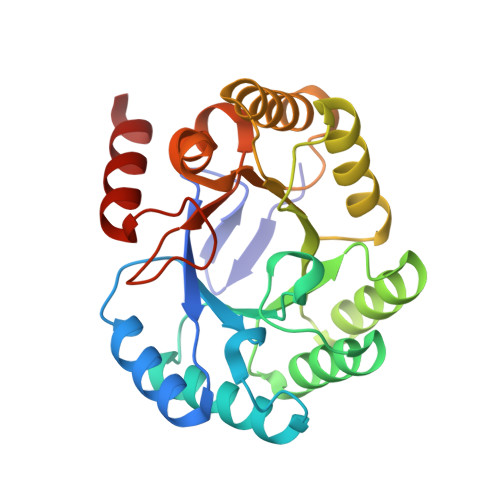Self-Immolation of a Bacterial Dehydratase Enzyme by its Epoxide Product.
Lence, E., Maneiro, M., Sanz-Gaitero, M., van Raaij, M.J., Thompson, P., Hawkins, A.R., Gonzalez-Bello, C.(2020) Chemistry 26: 8035-8044
- PubMed: 32259333
- DOI: https://doi.org/10.1002/chem.202000759
- Primary Citation of Related Structures:
6SFE, 6SFG, 6SFH - PubMed Abstract:
Disabling the bacterial capacity to cause infection is an innovative approach that has attracted significant attention to fight against superbugs. A relevant target for anti-virulence drug discovery is the type I dehydroquinase (DHQ1) enzyme. It was shown that the 2-hydroxyethylammonium derivative 3 has in vitro activity since it causes the covalent modification of the catalytic lysine residue of DHQ1. As this compound does not bear reactive electrophilic centers, how the chemical modification occurs is intriguing. We report here an integrated approach, which involves biochemical studies, X-ray crystallography and computational studies on the reaction path using combined quantum mechanics/molecular mechanics Umbrella Sampling Molecular Dynamics, that evidences that DHQ1 catalyzes its self-immolation by transforming the unreactive 2-hydroxyethylammonium group in 3 into an epoxide that triggers the lysine covalent modification. This finding might open opportunities for the design of lysine-targeted irreversible inhibitors bearing a 2-hydroxyethylammonium moiety as an epoxide proform, which to our knowledge has not been reported previously.
Organizational Affiliation:
Centro Singular de Investigación en Química Biolóxica e, Materiais Moleculares (CiQUS), Departamento de Química Orgánica, Universidade de Santiago de Compostela, Jenaro de la Fuente s/n, 15782, Santiago, de Compostela, Spain.
















